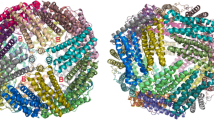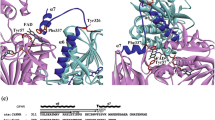Abstract
The recombinant Chlorobium tepidum ferritin (rCtFtn) is able to oxidize iron using ferroxidase activity but its ferroxidase activity is intermediate between the H-chain human ferritin and the L-chain human ferritin. The rCtFtn has an unusual C-terminal region composed of 12 histidine residues, as well as aspartate and glutamate residues. These residues act as potential metal ion ligands, and the rCtFtn homology model predicts that this region projects inside the protein cage. The rCtFtn also lacks a conserved Tyr residue in position 19. In order to know if those differences are responsible for the altered ferroxidase properties of rCtFtn, we introduced by site-directed mutagenesis a stop codon at position 166 and a Tyr residue replaced Ala19 in the gene of rCtFtn (rCtFtn 166). The rCtFtn166 keeps the canonical sequence considered important for the activity of this family of proteins. Therefore, we expected that rCtFtn 166 would possess similar properties to those described for this protein family. The rCtFtn 166 is able to bind, oxidize and store iron; and its activity is inhibit by Zn(II) as was described for other ferritins. However, the rCtFtn 166 possesses a decrease ferroxidase activity and protein stability compared with the wild type rCtFtn. The analysis of the Ala19Tyr rCtFtn shows that this change does not affect the kinetic of iron oxidation. Therefore, these results indicate that the C-terminal regions have an important role in the activity of the ferroxidase center and the stability of rCtFtn.






Similar content being viewed by others
Abbreviations
- Bfr:
-
Bacterioferritin
- FC:
-
Ferroxidase center
- GdnHCl:
-
Guanidine hydrochloride
- IPTG:
-
Isopropyl-β-d-thiogalactoside
- MOPS:
-
3-(N-morpholino)propane sulfonic acid
- PMSF:
-
Phenylmethane sulfonyl fluoride
- TEM:
-
Transmission electron microscopy
- WT:
-
Wild type
- YF :
-
Maximum fluorescence intensity changes emission
References
Arosio P, Ingrassia R, Cavadini P (2009) Ferritins: a family of molecules for iron storage, antioxidation and more. Biochim Biophys Acta 1790:589–599
Le Brun NE, Crow A, Murphy ME, Mauk AG, Moore GR (2010) Iron core mineralisation in prokaryotic ferritins. Biochim Biophys Acta 1800:732–744
Theil EC (2011) Ferritin protein nanocages use ion channels, catalytic sites, and nucleation channels to manage iron/oxygen chemistry. Curr Opin Chem Biol 15:304–311
Theil EC, Matzapetakis M, Liu XF (2006) Ferritins: iron/oxygen biominerals in protein nanocages. J Biol Inorg Chem 11:803–810
Treffry A, Bauminger ER, Hechel D, Hodson NW, Nowik I, Yewdall S, Harrison PM (1993) Defining the roles of the threefold channels in iron uptake, iron oxidation and iron-core formation in ferritin: a study aided by site-directed mutagenesis. Biochem J 296:721–728
Lawson DM, Artymiuk PJ, Yewdall SJ, Smith JM, Livingstone JC, Treffry A, Luzzago A, Levi S, Arosio P, Cesareni G (1991) Solving the structure of human H ferritin by genetically engineering intermolecular crystal contacts. Nature 349:541–544
Santambrogio P, Levi S, Cozzi A, Corsi B, Arosio P (1996) Evidence that the specificity of iron incorporation into homopolymers of human ferritin L- and H-chains is conferred by the nucleation and ferroxidase centres. Biochem J 314:139–144
Ha Y, Shi D, Small GW, Theil EC, Allewell NM (1999) Crystal structure of bullfrog M ferritin at 2.8 Ǻ resolution: analysis of subunit interactions and the binuclear metal center. J Biol Inorg Chem 4:243–256
Johnson E, Cascio D, Sawaya MR, Gingery M, Schröder I (2005) Crystal structures of a tetrahedral open pore ferritin from the hyperthermophilic archaeon Archaeoglobus fulgidus. Structure 13:637–648
Granier T, d’Estaintot BL, Gallois B, Chevalier JM, Precigoux G, Santambrogio P, Arosio P (2003) Structural description of the active sites of mouse L-chain ferritin at 1.2 Ǻ resolution. J Biol Inorg Chem 8:105–111
Tatur J, Hagen WR, Matias PM (2007) Crystal structure of the ferritin from the hyperthermophilic archaeal anaerobe Pyrococcus furiosus. J Biol Inorg Chem 12:615–630
Khare G, Gupta V, Nangpal P, Gupta RK, Sauter NK, Tyagi AK (2011) Ferritin structure from Mycobacterium tuberculosis: comparative study with homologues identifies extended C-terminus involved in ferroxidase activity. PLoS One 6:e18570. doi:10.1371/journal.pone.0018570
Stillman TJ, Hempstead PD, Artymiuk PJ, Andrews SC, Hudson AJ, Treffry A, Guest JR, Harrison PM (2001) The high-resolution X-ray crystallographic structure of the ferritin (EcFtnA) of Escherichia coli; comparison with human H ferritin (HuHF) and the structures of the Fe(3+) and Zn(2+) derivatives. J Mol Biol 307:587–603
Cho KJ, Shin HJ, Lee JH, Kim KJ, Park SS, Lee Y, Lee C, Kim KH (2009) The crystal structure of ferritin from Helicobacter pylori reveals unusual conformational changes for iron uptake. J Mol Biol 390:83–98
Masuda T, Goto F, Yoshihara T, Mikami B (2010) Crystal structure of plant ferritin reveals a novel metal binding site that functions as a transit site for metal transfer in ferritin. J Biol Chem 285:4049–4059
Zhao G, Ceci P, Ilari A, Giangiacomo L, Laue TM, Chiancone E, Chasteen ND (2002) Iron and hydrogen peroxide detoxification properties of DNA-binding protein from starved cells. A ferritin-like DNA-binding protein of Escherichia coli. J Biol Chem 277:27689–27696
Kauko A, Haataja S, Pulliainen AT, Finne J, Papageorgiou AC (2004) Crystal structure of Streptococcus suis Dps-like peroxide resistance protein Dpr: implications for iron incorporation. J Mol Biol 338:547–558
Halsey TA, Vazquez-Torres A, Gravdahl DJ, Fang FC, Libby SJ (2004) The ferritin-like Dps protein is required for Salmonella enterica serovar Typhimurium oxidative stress resistance and virulence. Infect Immun 72:1155–1158
Lawson TL, Crow A, Lewin A, Yasmin S, Moore GR, Le Brun NE (2009) Monitoring the iron status of the ferroxidase center of Escherichia coli bacterioferritin using fluorescence spectroscopy. Biochemistry 48:9031–9039
Macedo S, Romao CV, Mitchell E, Matias PM, Liu MY, Xavier AV, LeGall J, Teixeir M, Lindley P, Carrondo MA (2003) The nature of the di-iron site in the bacterioferritin from Desulfovibrio desulfuricans. Nat Struct Biol 10:285–290
Lawson DM, Treffry A, Artymiuk PJ, Harrison PM, Yewdall SJ, Luzzago A, Cesareni G, Levi S, Arosio P (1989) Identification of the ferroxidase centre in ferritin. FEBS Lett 254:207–210
Sun S, Arosio P, Levi S, Chasteen ND (1993) Ferroxidase kinetics of human liver apoferritin, recombinant H-chain apoferritin, and site-directed mutants. Biochemistry 32:9362–9369
Pereira AS, Small W, Krebs C, Tavares P, Edmondson DE, Theil EC, Huynh BH (1998) Direct spectroscopic and kinetic evidence for the involvement of a peroxodiferric intermediate during the ferroxidase reaction in fast ferritin mineralization. Biochemistry 37:9871–9876
Ebrahimi HK, Bill E, Hagedoorn PL, Hagen WR (2012) The catalytic center of ferritin regulates iron storage via Fe(II)–Fe(III) displacement. Nat Chem Biol 8:941–948
Yevenes AE, Marquez V, Watt RK (2011) Cloning and characterization of Chlorobium tepidum ferritin. Biochimie 93:352–360
Ingrassia R, Gerardi G, Biasiotto G, Arosio P (2006) Mutations of ferritin H chain C-terminus produced by nucleotide insertions have altered stability and functional properties. J Biochem 139:881–885
Levi S, Luzzago A, Franceschinelli F, Santambrogio P, Cesareni G, Arosio P (1989) Mutational analysis of the channel and loop sequences of human ferritin H-chain. Biochem J 264:381–388
Levi S, Luzzago A, Cesareni G, Cozzi A, Franceschinelli F, Albertini A, Arosio P (1998) Mechanism of ferritin iron uptake: activity of the H-chain and deletion mapping of the ferro-oxidase site. A study of iron uptake and ferro-oxidase activity of human liver, recombinant H-chain ferritins, and of two H-chain deletion mutants. J Biol Chem 263:18086–18092
Harrison PM, Arosio P (1996) The ferritins: molecular properties, iron storage function and cellular regulation. Biochim Biophys Acta 1275:161–203
Theil EC (1990) The ferritin family of iron storage proteins. Adv Enzymol Relat Areas Mol Biol 63:421–449
Paques EP, Paques A, Crichton RR (1980) A study of the mechanism of ferritin formation. The effect of pH, ionic strength and temperature, inhibition by imidazole and kinetic analysis. Eur J Biochem 107:447–453
Hennessy DJ, Reid GR, Smith FE, Thompson SL (1984) Ferene, a new spectrophotometric reagent for iron. Can J Chem 62:721–724
Le Brun NE, Keech AM, Mauk MR, Mauk AG, Andrews SC, Thomson AJ, Moore GR (1996) Charge compensated binding of divalent metals to bacterioferritin: H+ release associated with cobalt(II) and zinc(II) binding at dinuclear metal sites. FEBS Lett 397:159–163
Le Brun NE, Andrews SC, Guest JR, Harrison PM, Moore GR, Thomson AJ (1995) Identification of the ferroxidase centre of Escherichia coli bacterioferritin. Biochem J 312:385–392
Crow A, Lawson TL, Lewin A, Moore GR, Le Brun NE (2009) Structural basis for iron mineralization by bacterioferritin. J Am Chem Soc 131:6808–6813
Ebrahimi HK, Hagedoorn PL, Hagen WR (2010) Inhibition and stimulation of formation of the ferroxidase center and the iron core in Pyrococcus furiosus ferritin. J Biol Inorg Chem 15:1243–1253
Treffry A, Zhao Z, Quail MA, Guest JR, Harrison PM (1998) How the presence of three iron binding sites affects the iron storage function of the ferritin (EcFtnA) of Escherichia coli. FEBS Lett 432:213–218
Kasyutich O, Ilari A, Fiorillo A, Tatchev D, Hoell A, Ceci P (2010) Silver ion incorporation and nanoparticle formation inside the cavity of Pyrococcus furiosus ferritin: structural and size-distribution analyses. J Am Chem Soc 132:3621–3627
Schneider CA, Rasbanf WS, Eliceiri KW (2012) NIH image to ImageJ: 25 years of image analysis. Nat Methods 9:671–675
Goujon M, McWilliam H, Li W, Valentin F, Squizzato S, Paern J, Lopez R (2010) A new bioinformatics analysis tools framework at EMBL–EBI. Nucl Acids Res 38:W695–W699
Acknowledgments
This work was supported by Conicyt: Proyecto Inserción a la Academia 79090038 and Proyecto Anillo ACT 1107.
Author information
Authors and Affiliations
Corresponding author
Rights and permissions
About this article
Cite this article
Brito, C., Matias, C., González-Nilo, F.D. et al. The C-Terminal Regions Have an Important Role in the Activity of the Ferroxidase Center and the Stability of Chlorobium tepidum Ferritin. Protein J 33, 211–220 (2014). https://doi.org/10.1007/s10930-014-9552-3
Published:
Issue Date:
DOI: https://doi.org/10.1007/s10930-014-9552-3




